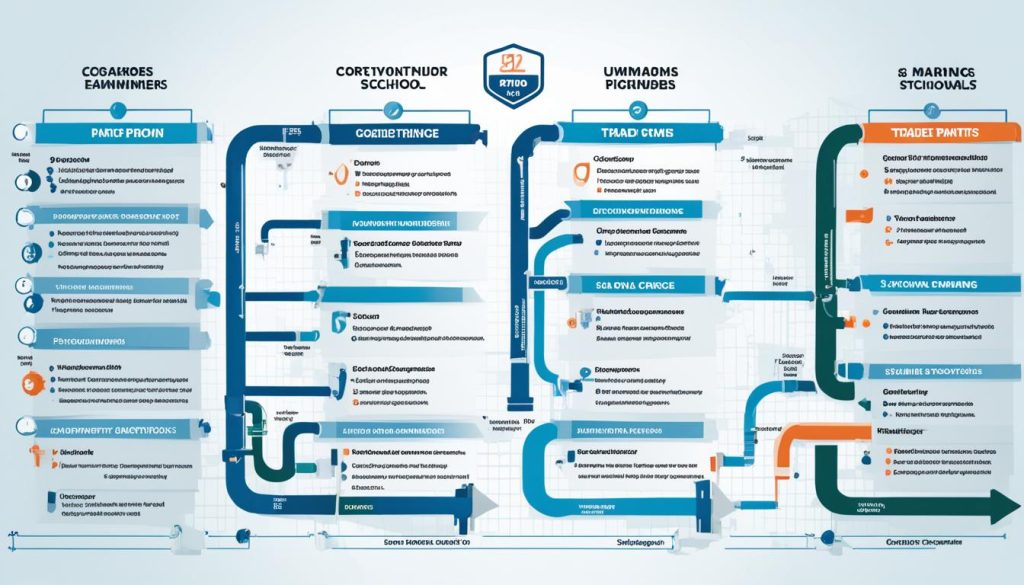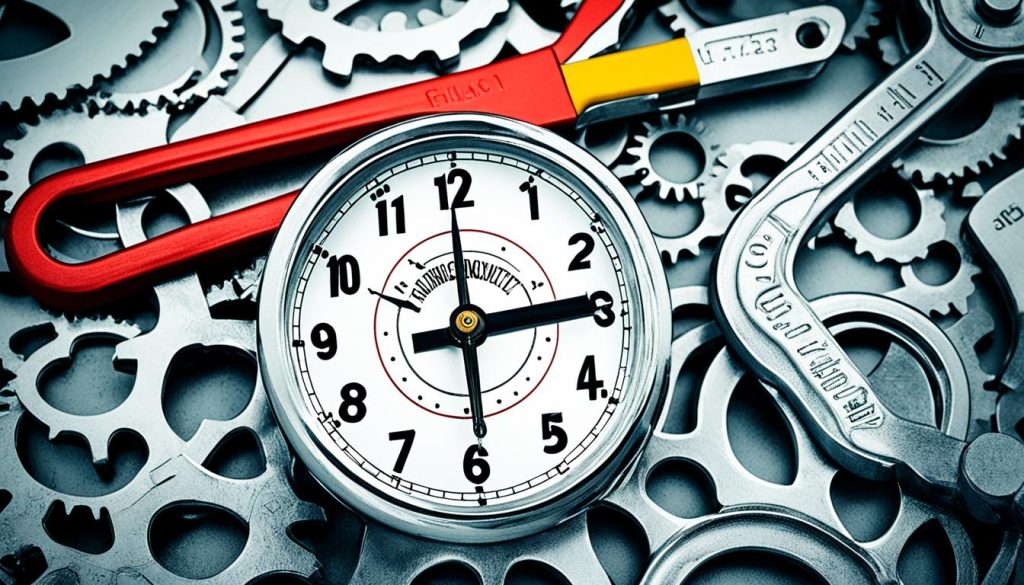Duration of Plumbing Trade School Programs
Did you know that plumbing trade school programs in Canada can vary in duration? Whether you’re considering a career in plumbing or looking to upgrade your skills, understanding the timeline of these programs is essential.
In the world of plumbing, time is of the essence. The plumbing industry is vital to the functioning of our homes, businesses, and communities, and skilled plumbers are always in high demand. So, how long does it take to complete a plumbing trade school program? Let’s dive into the details.
Types of Plumbing Programs Offered
In Ontario, there are two main categories of plumbing programs available: preparatory overview programs and apprenticeship programs. These programs offer different options for individuals interested in pursuing a career in plumbing.
Preparatory Overview Programs
Preparatory overview programs are designed to provide students with a comprehensive understanding of plumbing theory and practice. These programs typically last for one year and result in a certificate upon completion.
During a preparatory overview program, students will learn about a range of topics related to plumbing, including:
- Plumbing tools and piping methods
- Trade documentation
- Welding skills
- Safety techniques
By completing a preparatory overview program, students gain the fundamental knowledge and skills necessary to pursue a career in plumbing or continue their education in an apprenticeship program.
Apprenticeship Programs
Apprenticeship programs are designed for individuals who are already apprentices and have received an Offer of Training Letter from the Ministry of Colleges and Universities. These programs provide a combination of theoretical instruction and practical field experience to help aspiring plumbers develop their skills.
Apprenticeship programs typically span over two to three semesters and cover various aspects of plumbing, including:
- Advanced plumbing theories
- Practical applications
- Hands-on training
By completing an apprenticeship program, individuals can gain the necessary experience and knowledge to become fully licensed plumbers.
| Program Type | Duration | Key Features |
|---|---|---|
| Preparatory Overview Programs | 1 year |
|
| Apprenticeship Programs | 2-3 semesters |
|
Requirements for Plumbing Programs
To enroll in a plumbing program in Ontario, there are specific prerequisites and admission requirements that prospective students must meet. These requirements ensure that individuals entering the plumbing trade have the necessary skills and qualifications to succeed in their studies and future career.
Prerequisites
- Ontario Secondary School Diploma (OSSD) or equivalent
- Grade 12 English credit
Prospective students must hold an Ontario Secondary School Diploma (OSSD) or an equivalent qualification. Additionally, a grade 12 English credit is required, emphasizing the importance of strong communication skills in the plumbing field.
Physical stamina and self-discipline are also considered assets in the plumbing trade. The nature of the work requires individuals to handle physical tasks that may involve lifting heavy objects, working in confined spaces, and standing or kneeling for long periods. Moreover, self-discipline is essential for time management and adherence to safety protocols.
Apprenticeship Programs
For those interested in apprenticeship programs, additional requirements apply. Students must be registered by the Ministry of Advanced Education and Skills Development. This registration ensures that apprentices have met the necessary criteria to undergo hands-on training and classroom instruction.
Furthermore, some plumbing programs may require applicants to have a minimum of one year of trade experience. This experience helps students gain a foundational understanding of the plumbing industry and prepares them for the rigorous training and coursework involved in the program.
| Program Requirements | Prerequisites | Apprenticeship Registration | Trade Experience |
|---|---|---|---|
| Plumbing Programs | Ontario Secondary School Diploma (OSSD), Grade 12 English credit | Required | Some programs |
Plumbing Career Paths and Salaries
As a licensed plumber, you have a wide range of career paths available to you. Whether you prefer working on residential projects, commercial buildings, or industrial installations, there are plenty of job opportunities in the plumbing industry.
Many plumbers choose to work for established plumbing companies, where they can be involved in construction and development projects. This allows you to gain experience, learn from experienced plumbers, and work on a variety of exciting projects.
On the other hand, you may decide to go the independent route and build your own clientele. By establishing your own plumbing business, you can have more control over your work schedule, choose the type of projects you take on, and potentially earn a higher income.
When starting out as an entry-level plumber or apprentice, it’s important to note that salaries can vary. Some apprentices may begin with starting salaries as low as $25,000 per year. However, as you gain experience and advance in your career, your earning potential increases.
With certification and several years of experience, the average salary for licensed plumbers can reach around $50,000 per year. Keep in mind that union plumbers often earn higher salaries, with some reaching an annual income of approximately $70,000.
Here is a breakdown of the potential earnings for plumbers:
| Career Level | Annual Salary |
|---|---|
| Entry-Level/Apprentice | $25,000 |
| Licensed Plumber (Average) | $50,000 |
| Union Plumber | $70,000 |
It’s worth noting that these salary figures are approximate and can vary depending on factors such as location, years of experience, and additional certifications or specialties you may have. Nevertheless, the plumbing trade offers a promising earning potential for those willing to invest the time and effort into building a successful career.
Timeline of Plumbing Apprenticeship
The duration of a plumbing apprenticeship in Canada is typically four years, consisting of four 12-month periods. Throughout the apprenticeship, apprentices are required to complete a minimum of 1,560 hours of on-the-job training and attend eight weeks of classroom instruction each year. The curriculum is structured in a progressive manner, with each year focusing on different aspects of plumbing, including workplace safety, metal fabrication, heating systems, specialty piping, and more.
Plumbing Apprenticeship Timeline:
- Year 1: Introduction to plumbing theory and practice, workplace safety, basic tools and materials, metal fabrication, drawing and specifications.
- Year 2: Residential plumbing systems, drain-waste-vent and hydronic systems, heating systems, specialty piping.
- Year 3: Advanced topics – multi-family and commercial plumbing, electrical components, gas systems, venting.
- Year 4: Multi-story plumbing systems, private water supply, appliance wiring and installation, commissioning and servicing.
Educational Phases of Plumbing Apprenticeship
A plumbing apprenticeship consists of four educational phases that span over a period of four years. Each phase focuses on different aspects of plumbing, providing apprentices with a comprehensive understanding of the trade. Let’s take a closer look at the curriculum covered in each phase:
Phase 1: Foundational Skills
In the first year of the apprenticeship, apprentices learn the essential skills required for a successful career in plumbing. This phase covers workplace safety, basic plumbing tools and materials, metal fabrication, and drawing and specifications. It lays the foundation for the subsequent phases and ensures apprentices have a strong grasp of fundamental concepts.
Phase 2: Residential Plumbing Systems
The second year of the apprenticeship focuses on residential plumbing systems. Apprentices gain knowledge and hands-on experience in working with drain-waste-vent systems, hydronic systems, heating systems, and specialty piping. This phase equips apprentices with the skills necessary to handle residential plumbing projects and installations.
Phase 3: Advanced Topics
In the third year, apprentices delve into more advanced topics in the field of plumbing. This phase explores multi-family and commercial plumbing systems, electrical components related to plumbing, gas systems, and venting. Apprentices gain a deeper understanding of complex plumbing systems and develop the expertise required for larger-scale projects.
Phase 4: Specialized Skills
The final year of the apprenticeship focuses on specialized skills and advanced techniques. Apprentices learn about multi-story plumbing systems, private water supply, appliance wiring and installation, and commissioning and servicing. This phase prepares apprentices for the diverse challenges they may encounter in their plumbing careers.
Apprenticeship Education Performance
In order to succeed in apprenticeship education, apprentices must meet specific performance standards and achieve passing grades in both coursework and exams. The performance requirements and grading criteria are designed to ensure that apprentices attain the necessary knowledge and skills to excel in the plumbing trade.
Apprentices are evaluated on their performance in each section of the course, as well as on the final qualification exams administered by the Apprenticeship and Industry Training (AIT) board. The passing grade for each section of the course is generally set at 65%. This means that apprentices must demonstrate a solid understanding of the content and effectively apply their skills in practical scenarios in order to progress through the program.
In addition to course performance, apprentices must also achieve a passing mark on the provincial and interprovincial qualification exams. These exams assess the apprentice’s overall understanding of plumbing theory, practical skills, and safety procedures. The passing mark for these exams is typically set at 70%.
Once an apprentice successfully completes the apprenticeship program, they are awarded a journeyperson designation, which certifies their proficiency in the plumbing trade. This designation is not only a recognition of their educational achievements but also serves as proof of their expertise and eligibility to practice as a professional plumber.
Benefits of Meeting Performance Requirements
- Enhanced Knowledge and Skills: Achieving passing grades in the plumbing apprenticeship ensures that apprentices have a strong foundation of knowledge and skills required to excel in their careers.
- Professional Accreditation: Successful completion of the program and attainment of the journeyperson designation distinguishes apprentices as qualified and competent plumbers, boosting their professional reputation and employability.
- Expanded Job Opportunities: With a journeyperson designation in hand, graduates have access to a wider range of job opportunities and higher earning potential in the plumbing industry.
- Continued Learning and Growth: The apprenticeship education performance requirements set a high standard for excellence, encouraging apprentices to continue learning and upgrading their skills throughout their careers.
Image: Apprenticeship Education Performance
Tuition and Financial Assistance for Plumbing Programs
When it comes to pursuing a career in plumbing, understanding the cost of tuition fees and exploring financial assistance options is crucial. The cost of plumbing trade school programs may vary depending on the location and institution. In Alberta, for example, tuition fees for each period typically range from $1,056 to $1,375. However, apprentices should also consider additional expenses such as textbooks, modules, personal protective equipment (PPE), and other class-related items.
Fortunately, there are various financial assistance options available to support apprentices in their plumbing education journey. Student loans are an option worth exploring, as they provide a financial boost to cover educational costs. Additionally, grants and scholarships specifically designed for apprentices in the plumbing trade are valuable resources to consider. Students can also find support programs offered by reputable institutions like SAIT and the government, which can provide guidance and financial aid throughout their educational journey.
As an aspiring plumber, it’s essential to take advantage of these funding options to ensure that the financial responsibilities of your education are met. By assessing your eligibility for various financial assistance programs and exploring all available avenues, you can confidently focus on learning and honing your plumbing skills without unnecessary financial strain.
Source Links
- https://tradesecrets.alberta.ca/trades-in-alberta/profiles/006/
- https://www.sait.ca/apprenticeships-and-trades/programs/plumber
- https://www.ontariocolleges.ca/en/programs/professions-and-trades/plumbing
- Investing Wisely: How Windows & Doors in Boost Property Value and Financial Health - April 24, 2025
- The Financial Impact of Personal Injuries: Why Legal Help Matters for Business Owners - April 16, 2025
- The Hidden Financial Costs of Domestic Assault: What Business Owners Need to Know - April 16, 2025













